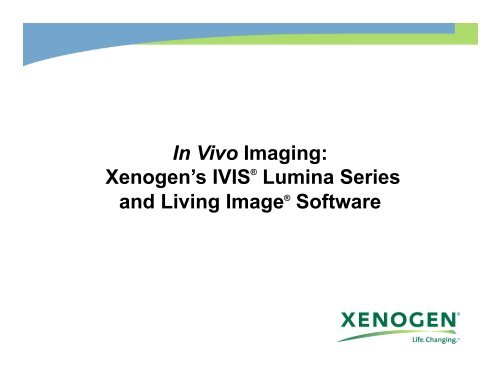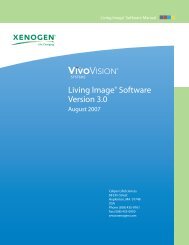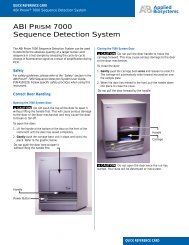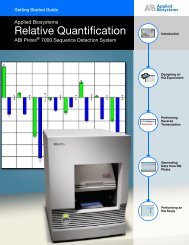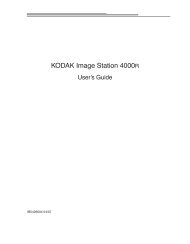IVIS Lumina Tutorial.PPT
IVIS Lumina Tutorial.PPT
IVIS Lumina Tutorial.PPT
- No tags were found...
Create successful ePaper yourself
Turn your PDF publications into a flip-book with our unique Google optimized e-Paper software.
In Vivo Imaging:Xenogen’s <strong>IVIS</strong> ® <strong>Lumina</strong> Seriesand Living Image ® Software
What Will Be CoveredIntroduction Science of in vivo Imaging Xenogen <strong>IVIS</strong> ® <strong>Lumina</strong> Series Hardware Overview Living Image ® Software Overview Fluorescence SystemTraining Hands on Training2
Why Optical In Vivo Imaging? Powerful labeling technique - gene expression results in productionof luciferase Tracer Applications: Amount of light is proportional to number of cells Functional Applications: Light is produced in response to a stimulus Non-invasive – does not require subject to be euthanized Relatively simple instrumentation. Users can run themselves – labinstrument, not imaging center3Science!
Photons Diffuse Through Tissue and the <strong>IVIS</strong> ®Views this Signal on the Surface of the SubjectCCDOptics Light traveling through tissuescatters many times creatinga "fuzzy" image at the surfaceof the animal The <strong>IVIS</strong> ® views the diffuse imageon the surface of the subjectBioluminescentSource7Science!
<strong>IVIS</strong> ® Imaging System <strong>Lumina</strong> Series – Hardware Customized for in vivo imaging High sensitivity from 300-900 nmLarge dynamic rangeLiving Image ® software8Hardware!
The <strong>IVIS</strong> ® Imaging ChamberCamera CoverOptical FilterWheelCCD Arrayf/1 Lens & ApertureShutterLED IlluminatorsHeatedSample StageLight-tightEnclosureElectronicsTray9Hardware!
Living Image ® Software Controls all settings in the <strong>IVIS</strong> ® Imaging System Provides advanced cataloging and browsing tools Provides analysis tools Instrument settings are analogous to photography Images are acquired in a two step process10 Software!
Standard Images are Composed of Two ImagesPhotographic + Luminescent = Overlay11 Software – Acquisition!
Camera and Lens Settings are Analogousto Those Used in Standard Photography Field of View (FOV) is dependenton the distance from the lens tothe sampleCCD Shutter Lens Aperture (f/stop) Emission Filters Light collected is proportional tothe time the shutter is open(exposure time) Aperture (f/stop) controls amountof light collected and depth-of-field CCD Binning is the resolution settingABCField of View!D12 Software – Acquisition!
Field of ViewFOV D = 12.5 x 12.5 cmFOV C = 10 x 10 cmFOV B = 7.5 x 7.5 cmFOV A = 5 x 5 cm13Software – Acquisition!
Setting Sensitivity – Luminescent Signal Level The <strong>IVIS</strong> ® CCD camera has a raw signal range of 0 to 65535Analog to Digital Counts (2 16 ). Adjust camera settings to obtain a signal level of 600 to60,000 counts. Settings that control signal level are: Exposure time Binning (CCD Resolution) f/stop (Aperture) Instrument is calibrated to automatically compensate for changes insensitivity settings14Software!
System Control PanelControls Sensitivity"Affects Sensitivity"15Software – Acquisition!
Exposure Time Luminescent signal level isproportional to exposure time. Shorter exposure timeimproves throughput. Longer exposure time increases signal Min exposure time = 0.5 second Max exposure time= 5 minutes2 sec f/1 small binning~5000 counts peak10 sec f/1 small binning~25000 counts peak16Software – Acquisition!
f/stop (Lens Aperture) f/stop controls the amount oflight received by the CCD f/1 is wide open Max light collection, defaultfor luminescent f/16 is smallest aperture Best resolution, defaultfor photof/1"f/16"17Software – Acquisition!
Pixel Binning (CCD Resolution) Binning refers to the grouping ofpixels into a larger super-pixel Large Binning = High Sensitivity/Lower resolution Small Binning = High Resolution/Lower Sensitivity18Software – Acquisition!
Summary of Basic Camera SettingsControls Sensitivity"Affects Sensitivity"19Software – Acquisition!
Acquisition – Single ImageOverlay will automatically take Photo + Luminescent"Single Image Acquisition"20Software – Acquisition!
Acquisition – Sequential modeAllows automatic acquisition of a seriesof images separated by fixed time points.21StartsSequentialImageAcquisition"Easy to useSequence Editor"Software – Acquisition!
Image Labeling Good labeling practices are necessaryfor effective data browsing22 Software – Cataloging!
Image Cataloging & Browsing Tools23Software – Cataloging!
Regions of Interest ToolsROI’s available are:ContourCircleSquareGrid Free Draw24 Software – Analysis!
Calibrated Physical UnitsLiving Image ® automatically compensates for device settings: Integration Time, f/stop, Binning, and Field of View Calibrated units are Photons per Second, representing theflux radiating omni-directionally from a user defined region.25Software – Analysis!
Calibrated Physical Units vs Raw Signal - ExampleRaw Signalin Counts Time: 30 sec 30 sec 60 sec 60 sec 60 sec 60 sec Binning: small small small small medium medium Day Number: 1 2 3 4 5 6 PeakCounts 1600 1200 800 400 26 Software - Analysis!
Calibrated Physical Units vs Raw Signal- ExampleCalibratedSignal inPhotonsper second Time: 30 sec 30 sec 60 sec 60 sec 60 sec 60 sec Binning: small small small small medium medium Day Number: 1 2 3 4 5 6 Photonsper second 27 Software - Analysis!
Measurement Table Measurement Table displays information about eachRegion of Interest in the image. Measurement Table is user configurable and can beexported to a spreadsheet28 Software – Analysis!
Fluorescence ProcessFluorophoreExcitation LightexcitedstateUp ShiftedEmission Lightgroundstate29Fluorescence!
<strong>IVIS</strong> ® <strong>Lumina</strong>’s Fluorescence Components Fully computer controlled Eight position Emissionfilter wheel Twelve positionExcitation filter wheel Low Auto Fluorescenceoptics and fiber optics 150 Watt Tungsten/Halogen lampwith computer controlled intensity30 Fluorescence!
Excitation and Emission Filters710 -760 nm 810 -875 nm 0.1normalized "intensity"0.10.1615 -665 nm 695 -770 nm 0.1500 -550 nm 575 -650 nm 445 -490 nm 515 -575 nm 32 Fluorescence!
Fluorescent Calibrated Units: EfficiencyEfficiency (%) =Emission Light (photons/sec) __________________________ Excitation Light (photons/sec) 33Fluorescence!
Fluorescent Calibrated Units: EfficiencyExcitation Light PatternUnits of Efficiency compensates fornon-uniform excitation lightpattern GFP Well Plate Corrected: EfficiencyGFP Well Plate Uncorrected:Photons or Counts34Fluorescence!
Autofluorescence of Control MiceAlfalfa Free Rodent FoodGFP DsRed Cy5.5 ICG35Fluorescence!
Animal Diet and Autofluorescence in Control MiceRegular Rodent FoodAlfalfa Free Rodent FoodCy5.5Cy5.536Fluorescence!
Autofluorescence Background Excitation FiltersFluorescentImageAnimal autofluorescenceimage using backgroundexcitation filterCorrectedImage37Fluorescence!
Background Excitation Filters665-695 710 -760 nm 810 -875 nm normalized "intensity"580-610 615 -665 nm 695 -770 nm 460-490 500 -550 nm 575 -650 nm 410-440 445 -490 nm 515 -575 nm 38Fluorescence!
For an In Depth Study – Software Manual39 Software!
What we’ve covered . . .Science Light is scattered and absorbed by tissue dependent on wavelength of light Calibrated physical units compensate for device settingsHardware Custom designed for in vivo bioluminescent imaging Settings are analogous to photographySoftware Images are acquired in a two step process Sensitivity is controlled by Integration Time, f/stop, and Binning Living Image ® controls <strong>IVIS</strong> ® and provides image analysis toolFluorescence Tissue Autofluorescence and Instrument Background can be subtracted40www.xenogen.com


